Looking to buy an Oud?
There is a lot of information about Ouds out there, and it is all over the place.
So I decided to put it all in one place here with pictures and infographics and call it the Ultimate Oud Buyers’ Guide!
Whether you are entering the world of Ouds or you have played it for some time, read this 5-part Ultimate Oud Buyers’ Guide (not sponsored by any makers or shops) before you buy.
The Ultimate Oud Buyers’ Guide will cover the following topics in detail:
Part 1: Types and Characteristics of Ouds
Part 3: How to Buy an Oud in a Foreign Country
Already have an Oud? Start learning how to play it here!
So let’s get started!
Part 1: Types of Ouds
The first step that one must take in order to enter the world of the Oud is to decide which type of Oud he or she wants to wield.
It is your weapon, it is your staff, it is your wand. The sound it makes creates your identity as an Oud player.
Are you the sound of the desert sand dunes? Or are you the sound of charging horses galloping across green steppes?
These are the many colours and flavours of the Oud which you can achieve. There are many choices to choose from. The Oud has evolved over many thousands of years, and it took sometime before even I could understand the differences between different types of Ouds.
Below is a general outline of the types of Ouds by region and style. This information will give you what it took me years to discover.
Arabic Ouds
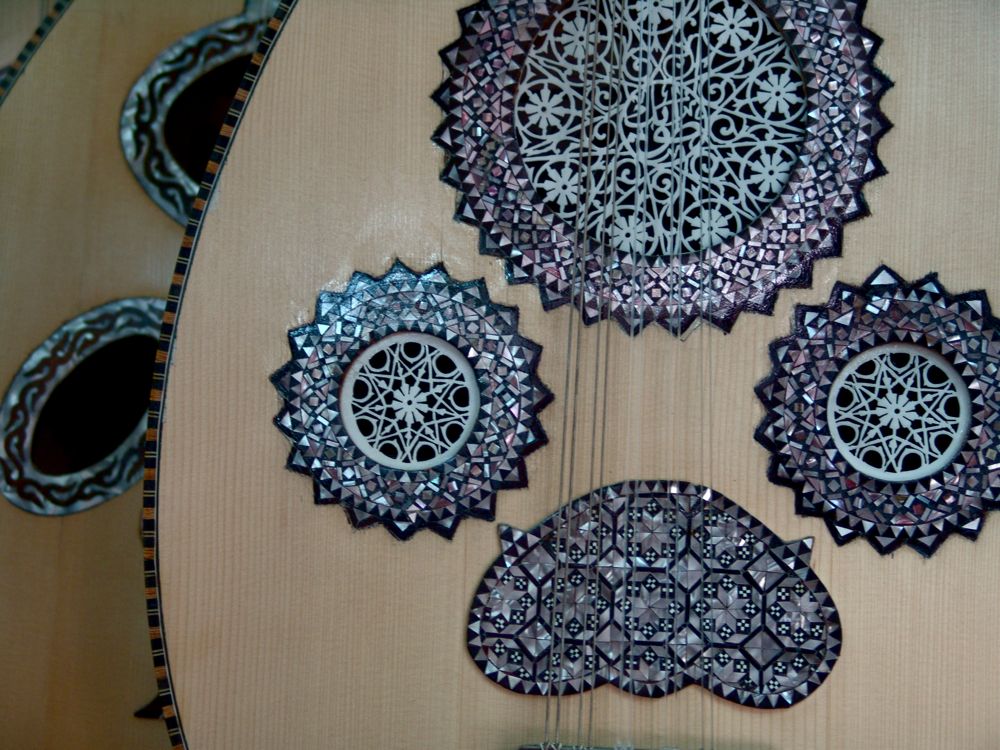
Where:
The most common type of Oud is an Arabic Oud. It is used in North Africa, Palestine, Lebanon, Jordan, Syria, Iraq, the Arabian Peninsula, and Iran.
Sound:
The Arabic Oud is the most romantic sounding of all the Oud types. It has a deep, round, and well-balanced sound. The highest strings cut through and stick out through an ensemble, and the bass strings give a nice smooth rumble. It typically features shorter sustain, and this is preferred by Arab players.

Construction:
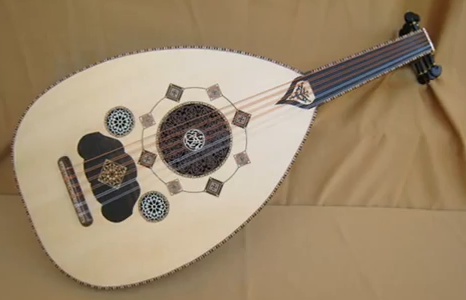
The Arabic Oud has many forms. In general, an Arabic Oud is usually between 61-62 cm from the bridge to the nut. One or three sound holes are common, which are usually adorned with rosettes. They can be made out a mix of different types of woods. The soundboard is thicker than Turkish Ouds in comparison.
The Oud may be ornate or simple. There is a lot of variation in style and design in these Ouds, but the bowl shape is large and round creating a deep mellow tone. The pegs are the same as all Ouds, friction style similar to Violin pegs.
Most models now hold five double course nylon strings with a single low bass string for a total of 11 strings. It is possible to find 10 string Ouds and 12, but 11 string is the norm.
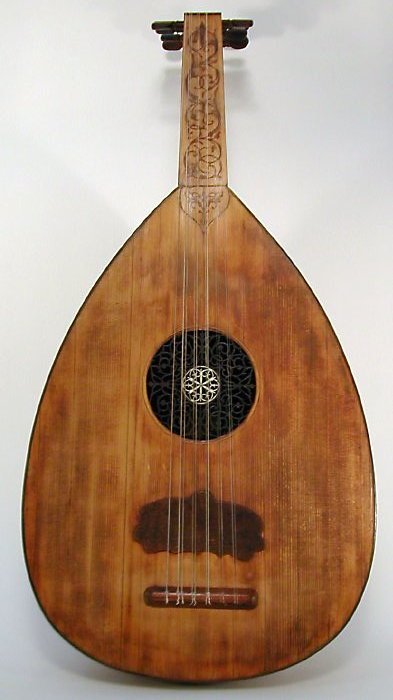
Turkish Ouds
Where:
The Turkish Oud is a totally different breed of Oud with different construction and unique sound. They can be found primarily in Turkey and Greece.
Sound:
I didn’t mention charging horses for nothing. Here it is. The Turkish sound is filled with action and brightness. It is tuned a whole step higher than the Arabic Oud. It produces a longer sustain than Arabic Ouds, and definitely cuts through an ensemble. There is higher tension in the strings and a thinner soundboard producing sound in the middle and high frequencies. It is easy to hear vibrato in these Ouds.
Construction:

Turkish Ouds are fairly easy to spot. It is not always the case, but the soundboard is very rarely coated. It is usually a very light wood colour most likely due to use of spruce. The fingerboard and soundboard are usually flush. Where the fingerboard joins the soundboard, there is a small ornament that looks like an extension of the fingerboard that joins to a point as the picture to the right.
This is a very general ornament that might tell you immediately what kind of Oud you are looking at. However, some Arabic Ouds have this ornament as well.
Turkish Ouds are slightly smaller than their Arabic counterparts. They are about 58.5 cm in length from the bridge to the nut.
An important factor about Turkish Ouds is that factory made Turkish Ouds are more reliable than factory-made Arabic Ouds. It is possible to get a decent Turkish Oud under $500. That being said however, these still may not be long lasting, as the thinner soundboard tends to decrease the lifespan of the Oud. But the bright, clear sound is the preferred sound in Turkish Ouds. Turkish Ouds usually come with three sound holes that are slightly smaller than Arabic Ouds’ sound holes and are usually adorned with rosettes. The numerous Oud builders and mass production of Ouds in Turkey have led this market to be quite competitive, and it is easy to find a decent Oud at low cost from Turkey.
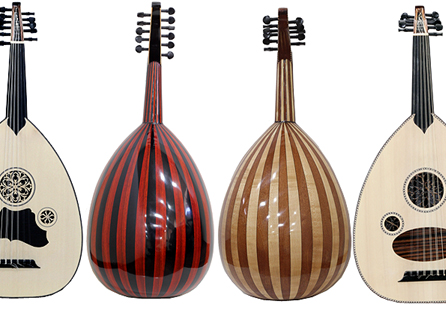
Iraqi Ouds
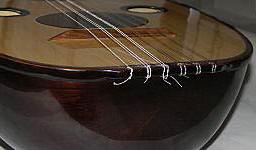
The Ouds you find in Iraq are also part of the Arabic family. In the last century a new design was developed by Mohammed Fadel Hussein. This Oud features a floating bridge, similar to Mandolin and Irish Bouzoukis. It also usually features oval sound holes without rosettes. These along with other construction differences creates an Oud with a unique sound. Some say it is more similar to a guitar in that the middle range frequencies come out creating a clean and full sound. Nowadays, this style of Oud is built by all Oud builders. You can find low cost floating bridge Ouds from most Oud factories.
If you want a higher end floating bridge Oud, all the best Luthiers offer these models as well.
Iranian Ouds
In Iran there are two types of Ouds. The first is the Arabic Oud, which is tuned in the same way and more comparable in sound to the Arabic Oud than the Turkish Oud. The second type is called Barbat. It is gaining more popularity because it is a reinvention of the ancient Barbat that was used in Iran before the Islamic conquest. It is believed to be the predecessor of the Arabic Oud and is now made by many Luthiers in Iran. There are several types of Barbat worth mentioning:
Ghanbari Barbat by Mohammadi Brothers
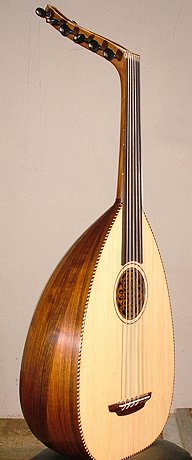
Skin top Barbat
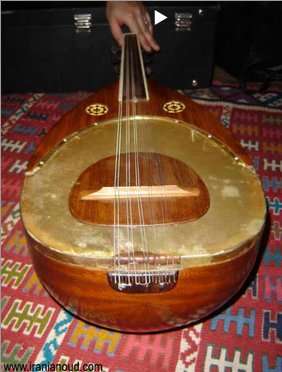
Arafati Barbat
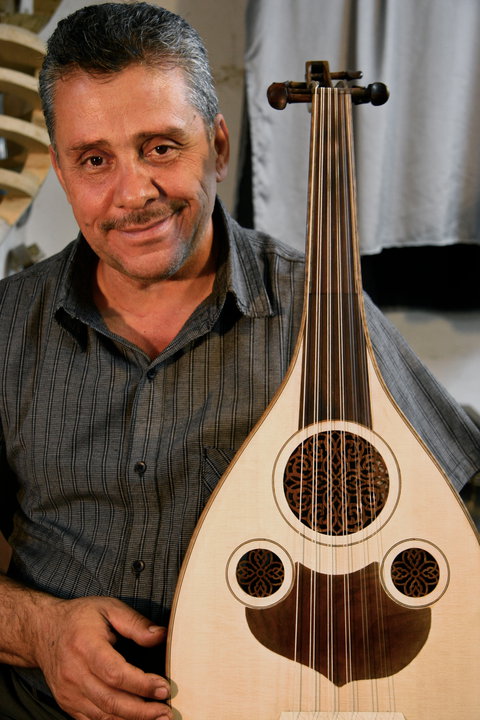
Sound:
At first, the difference between Arabic Oud and the sound of the Barbat might be difficult to distinguish in audio recordings.
The Barbat usually consists of five paired courses, but six paired courses can be ordered as well. The low bass strings are punchy and clear. They are thick sounding and sound more full than that of Arabic Ouds’ bass strings. The middle range is also very clear and very clean. I find that the high strings and the notes in the high register is clean and clear but lacks the same fullness and attack that is present in Arabic Ouds. The sound is more airy.
All around this is a mellower beast than its Arabic counterpart. It is quite good for Persian music and ensemble work because it mixes well in a Persian ensemble. Hossein Behroozinia has helped reestablish the Barbat in traditional Persian music. This is what a Barbat sounds like.
Construction:
The Barbat has a smaller bowl than both Arabic and Turkish Ouds. The bowl may be slightly deeper than other Ouds. The bowl is shaped such that it reveals more of the neck allowing easier access to higher notes on the finger board. On Arabic Ouds and Turkish Ouds, the bowl meets where the 5th note of each string is located on the fingerboard, whereas the Barbat bowl reaches to the 6th note.
Electric Ouds
Electric Ouds are a new creation that have been designed in multiple forms. There are a few Oud builders that make them now.
There isn’t much that is special about these Ouds except that you can plug them in and go nuts. Which may be exactly what you’re looking for.
Most are solid body, but one Electric Oud created by Godin guitars is attracting a lot of attention because of the excellent sound, playability, and electronics that you can work with.
If you are curious, read our Godin MultiOud Review.
Before you go electric, it’s good to remember that…
If you are a traditionalist, or like a warm sound, this is probably not the way to go. But if you play more electric music and want to experiment with different sound effects and don’t want to spend a lot of money, an electric Oud of some kind may be the right choice for you.
Sound:
When it comes to sound on electric Ouds, it is really up to you and the equipment you have at your disposal. But do not expect a true traditional Oud sound. This also holds true for the flatback Godin MultiOud. It closely resembles the Turkish Oud, but lacks the deep, full sound that only a true bowl and traditional soundboard can create.
Some Luthiers like Dmitri Rapakousious also have their own flatback electric Oud models that are both acoustic and electric, which give a more authentic sound when played acoustically and electrically. However, the Godin MultiOud has exceptional electronics.
Oud Comparison
The following is a very basic beginner guideline. Every Oud will sound different, and every Oud builder creates a unique sound.
If you want a well-balanced Oud sound with a combination of deep bass, warmth and versatility, perhaps an Arabic Oud is a good choice.
If you want a unique sound and an Oud with a little more sustain, the Turkish Oud is a good idea. Keep in mind, most modern Turkish Ouds, with the exception of custom Faruk Turunz Ouds have a thin soundboard in comparison to Arabic Ouds. This may make them more delicate, or shorten their lifespan depending on how rough you are with it. Many Turkish Luthiers make custom Arabic Ouds as well.
If you have a very unique taste and are looking for something mellow that doesn’t sound like any other Oud out there, you might want to consider looking into a Barbat. However, a Barbat may be the most expensive and hard to come by, but it may be exactly what you’re looking for. If you do find yourself in possession of a Barbat, you will have a one of a kind instrument that was made with superb and beautiful craftsmanship.
What You Need to Know Before Buying
You must choose carefully when buying an Oud because it may take you a while to find, choose, locate/ship. Once you get your Oud you must be happy with it.
I first recommend that you go back to the first recording of Oud that you fell in love with and find out what style of Oud that is. This will help you narrow your quest to find the right Oud considerably.
Then I recommend going on YouTube and listening to all kinds of Oud players out there; Turkish, Arabic, Iranian, old school players, modern players… whatever. Find the sound you like.
After you find out what kind of Oud you want to play, decide what your budget will be. This will help you determine where to go for your next Oud.
Later articles in this guide will also provide some information on how to order from Luthiers or how to bargain in stores in the Middle East.
Women’s Ouds
Luthiers also make custom women’s size Ouds with a smaller bowl. There are also some factory made options for women size Ouds too. Details will be included under Oud Makers chapter.
Tunings
Turkish: low strings to high strings C#F#BEad – EA BEad – DABEad – DGBEad
Arabic/Iraqi: CFADgc – DGADgc – FADgcf
Iranian (Usually Five course) GADgc – FADgc – EADgc
Buy Your Dream Oud
>>Move onto Part 2: Oud Makers to learn more about where to buy your next Oud! →







Good to see this information up and available. Yuri
I have no music playing experience, but I am determined to play,the out. It is the most beautiful instrument I have ever heard.
That’s great to hear. Don’t be discouraged if you don’t read music either, back in the old days, Middle Eastern music was learned all by ear, by listening and repeating. You can use these video lessons if you want to learn by ear too. Let me know if I can assist you in any way.
I have caught the oud bug and this site has been just what the Dr ordered! I live in Toronto Canada. I found a Greek chap who plays and teaches however they do not have an instrument for me to use or even rent! So, I have been hunting without luck. My particular strain of the bug is for an Arabic oud. Something about the, for lack of a better word,”mystical” sound….at least to my ear. One fellow I found from your writings. I entered into an email exchange with this very nice man. I thought I would drive to Montreal to buy an oud however his are not Arabic ouds. Gorgeous, amazing looking instruments however not right for me.
So, I have been thinking of taking a vacation/shopping trip to the middle east. Then it occurred to me that people you might know may already know a couple of shops and addresses where I might head instead of an open ticket to Cairo or Behrut!
Any thoughts?
Alf
416-271-8976
Most definitely! I suggest registering on mikeouds.com at the forums section to look for specific addresses for shops in Cairo and Beirut. If you’re going to Cairo, there are a many Oud shops that you can avail yourself of, but it’s best to make a direct question or search on the forum, because there are very knowledgeable individuals on the forum who live in the area that can point you in a specific direction so that you can find something both affordable and good quality. In Cairo, Shehata is quite well known. There are also many Oud shops in Beirut from reputable builders. Let me know if there is anything else I can help you with.
There is also a good site that has addresses of instrument builders all over the world. http://www.musiciansguidemap.com/ This might help you get a general idea of where to go and then you can get specifics from mikeouds forums.
Dear Guys,
i have two antique ouds to sell. One is Samli İskender (Armenian) and the other one is Arou-Halep (Arabian). People who are interested might contact me by e-mail. I may send you the pictures of them. My e-mail is: atillaerturk82@yahoo.com.tr
Regards,
Atilla
Also make a post on Mike’s Oud Forums http://www.mikeouds.com/messageboard/ that way you may be able to reach more people.
Great Article, Wow!!!
Thanks! Let us know if you have any questions.
The Ultimate Oud Buyer’s Guide is excellent, very informative,great future resource!
Thanks Alex.
Yes nice
Enjoying your site! Yes, i’m another guitarist who has been interested in learning the oud and ‘modal’ music in general. I’ve tried to follow your guidelines (and ones on mike’s oud forum) in order to choose an oud according to the sounds and music that i like. I’m very attracted to the type of oud and music played by efren lopez on this video:
https://m.youtube.com/watch?v=p2zv0cfEDqQ
Is this a turkish oud? (Seems like one, but i can’t tell)…if it is a turkish oud, would i be able to use your course (which seems to be centered on arabic)? How would that work (or not)?
Thank you,
Dan
Hi Dan,
Yes it is a Turkish Oud. If you want to use a Turkish Oud, you just have to tune it down a full step or a whole step down to Arabic tuning to use the course. The Oud will not sound exactly as it should but it will be good enough for practicing. The string tension will be a bit looser than usual.
Efren Lopez has some cool music, that’s a good place to get inspired from.
Actually it’s an Arabic Oud in Arabic tuning made by a Turkish maker, my mistake. There are a bunch of Turkish Oud builders catering to Arabic buyers and they are making Ouds for Arabic tuning now too.
Thanks for you reply! Now i have to change my strategy for finding one….
I guess it’s like this one on ebay:
http://www.ebay.com/itm/301409399822?_trksid=p2055119.m1438.l2649&ssPageName=STRK%3AMEBIDX%3AIT
An arab-style sandi which they say an be tuned to both arab and turkish tuning (do you think that’s true in your experience?)…it also sports the typically turkish lower fingerboard ornament….all these exceptions to the rule 🙂
Best to you,
Dan
To be honest, all their Ouds “sound” more Turkish, but can be played in Arabic tuning. You can play any Turkish Oud in Arabic tuning because it’s just tuning the Oud down a full-step (one note). But depending on type of Oud strings you have on their and the length of the instrument it might not sound as good as if it was in Turkish tuning. It’s a complicated issue, which I don’t have a perfect answer for you, but you could play it in Arabic tuning provided you put an Arabic string set on the Oud. It’s all related to string thickness, scale length, and string tension. Arabic Ouds are usually 61.5 cm scale length, so the strings need to be ever so slightly thicker to work well in the traditional tuning. So if you take a Turkish Oud which is usually 58 cm or 59 cm in scale length and tune it down to Arabic tuning, the strings might be too loose to give an ideal sound. So you put heavier strings on it like Aquila Oud strings to compensate for the shorter scale length. Depending on the Oud and the strings, people get different results.
For the Oud you posted, they have gone a middle way by making the Oud string or scale length 60 cm. This is kind of in between an Arabic Oud and Turkish Oud scale length, so it could work with both tunings. You may have to experiment with different strings to get your preferred results, but you could probably just get it and go with this one.
If Sandi Ouds are your only option, they are definitely a decent choice.
Navid,
Ah, i understand, now….Very in depth response, very much appreciated! I think i have one final question which others might be wondering, too:
If i were to get a fretless guitar, would i still be able to follow along with your course and learn something of the maqam system? (Playing the music, not on the oud, but on the guitar?)
Best,
Dan
Yes, totally.
Hi Navid. Thanks for your awesome information. Have you tried playing Persian music on turkish oud?
I haven’t really spent a lot of time playing Persian music on Turkish Oud, only Arabic Ouds. I don’t own a Turkish Oud, only played them in shops. But I don’t see why not.
The tuning of Turkish Oud is much higher than most of the keys used in Persian music, so if you tune a Turkish Oud to Persian tuning (which is like Arabic tuning) it might sound different because the strings are looser.
Hello,
Thank you for providing this concise information.
I am a beginner. A real beginner I mean. So sorry if my question sounds very simple. I bought a Turkish oud and then in the videos I noticed that the fingerboard of some ouds is extended to the central hole. Does this mean that Turkish ouds are not capable of being played in that range? I mean there is no fingerboard there. Do professional Turkish oud players use those areas?
Thank you so much.
No problem, no question is too simple. That’s a good question. Pro Turkish players do use those areas. It’s a matter of style. It might make playing up there just a touch easier, but it’s not essential. You’ll only ever play the most technically advanced music in that position anyway. Most playing happens on the neck, so it’s nothing you need to worry about. You’ll see some Oud players who’ve played their Ouds up in high positions have stained their Ouds with the oil from their hands, because playing on the sound board is quite normal for that design of Oud.
Hello Navid,
Your guide is very helpful …. Do you know of anywhere reliable in or close to Amman that I could purchase a quality Oud (probably Arabic style but I’m open). Heard some live music (Oud & percussion) the other night and I’m hooked, I’m a guitarist for years.
Thank you ….
Yes, absolutely. Find Omar Abbad in Amman. He’s a great teacher and an find you an Oud at his music shop. Amman-Cresendo Music School. https://www.facebook.com/CrescendoAcademy/
A friend of mine bought a beginner Oud from him and he loves it. If you meet him, please say hello to him for me.
Great article, Navid.
Regards from Peru.
Has anyone heard of this brand? i just bought this oud used for cheap, supposadley it comes from Mohammed Ali street in Cairo
Has anyone heard of this brand? i just bought this oud used for cheap, supposedly it comes from Mohammed Ali street in Cairo
https://scontent-ort2-1.xx.fbcdn.net/v/t31.0-8/15972660_10154535799314213_3886995939386928085_o.jpg?oh=8a3d1da39e778a971c0c26c58d223533&oe=58DDC3A0
I have an Egyptian oud and would like to find a wooden stand for it. Can anyone help me?